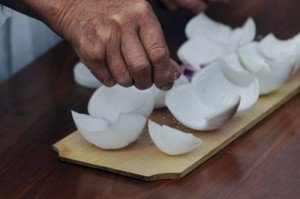Luca Day in Hungary

The 13th of December is named “Luca Day” in Hungary, and has many folkways and traditions. Before the Gregorian calendar, this was the winter solstice, which means the shortest daytime and the longest night of the year. It also was the darkest day of the year, the day of the evil, when – it was believed – people needed to protect themselves from witches. It was the day of magical spells and actions which have been undertaken to end the rule of the evil. The name Luca comes from the Latin “lux” which means light, and this is why Saint Luca is referred to as the light bearer.
Legend has it that Lucia, born into a noble family, once went on a pilgrimage with her sick mother to the grave of Saint Agatha, Catania, to ask for her mother’s recovery. After the magical recovery Lucia vowed to chastity and cancelled her wedding. To take revenge, her fiancé reported her to the judge for her faith. They wanted to put her through torture but they weren’t able to violate her so they decided to burn her at the stake. Neither fire, nor hot oil could hurt her, so they stabbed her throat with a sword. Still, she only died after she finished her prayer.
 People tried to forecast the weather based on the period between Luca Day and Christmas. This meant 12 days which represented the weather of the next 12 months. This is called the Luca calendar. Another way to forecast the weather was the ‘onion calendar’ which meant cutting an onion into 12 pieces and putting salt on the pieces. The piece that became the most moisty represented the rainiest month in the following year.
People tried to forecast the weather based on the period between Luca Day and Christmas. This meant 12 days which represented the weather of the next 12 months. This is called the Luca calendar. Another way to forecast the weather was the ‘onion calendar’ which meant cutting an onion into 12 pieces and putting salt on the pieces. The piece that became the most moisty represented the rainiest month in the following year.
The most famous tradition is the carving of the Luca chair which is made out of 9 different wood types and forms a pentagon. It needed to be finished until Christmas Eve but you could only do one procedure a day. This is where the saying ‘It is made slowly like the Luca chair’ comes from. The maker of the chair then took it to the midnight mass. If he sat on the chair he could see who the witches were. Then he had to run home quickly while sprinkling poppy seeds behind his back so that his chasers couldn’t catch him. At home everyone was safe, but the maker had to burn the chair.
The planting of wheat is also connected to Luca Day. You put the wheat into smaller pottery and water it until Christmas. Candles are usually put inside as well. The more it grows and the greener it gets the richer the next year will be. It was forbidden to do any kind of house work on this day because it could cause misfortune.
Another tradition is ‘kotyolás’ which means that boys went from house to house and told spells that enhanced fertility. This tradition helped to make the next year’s production abundant and also with the increment of animals. The boys kneeled on straw while telling their spells and usually got a small present in exchange. Sometimes the housewife sprinkled the boys with water or corn and the leftovers were eaten by the hens. “Luca, Luca kitty-kotty…”
 Unwedded women tried to forecast the name of their future husband by writing 12 names on small pieces of paper and burning one piece per day until Christmas. The name on the last piece was believed to be the name of the One. Last but not least, another way to forecast the future husband’s name was to put these pieces of paper into dumplings. Girls then started cooking the dumplings in boiling water and the one which first came up to the surface of the water was the one containing the right name.
Unwedded women tried to forecast the name of their future husband by writing 12 names on small pieces of paper and burning one piece per day until Christmas. The name on the last piece was believed to be the name of the One. Last but not least, another way to forecast the future husband’s name was to put these pieces of paper into dumplings. Girls then started cooking the dumplings in boiling water and the one which first came up to the surface of the water was the one containing the right name.
Written by Alexandra Béni
Photos: www.facebook.com/Lucaszéke
Copy editor: bm
Source: Daily News Hungary






[…] of Hungary’s most famous holiday folk traditions is the carving of the Luca Chair. Made of nine different types of wood, the Luca chair was to be carved by Christmas Eve. The hitch: Only one carving was permitted per day. Once the chair was complete, its maker would […]